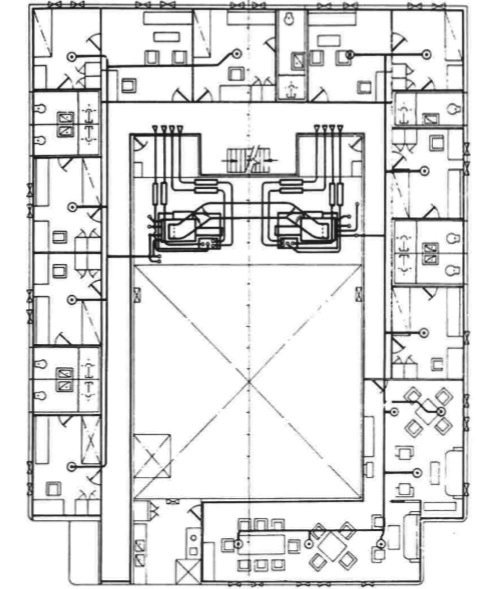
Home page||Air conditioning ||
Marine air conditioning system- function of air terminals
Good ventilation is vital to the health and well-being of those on board ship and the general requirements for ventilation, formulated before the universal installation of air conditioning systems, still apply.
Heating, always necessary for the colder areas of the world, has in the past been provided by local radiators or by heating coils incorporated with ventilation units. With extremes of low temperature, these primitive methods of heating increased the capacity of the air to absorb moisture and caused excessive evaporation with discomfort to crew and passengers due to drying of the nasal passages, throat and skin.
Air terminals
The best designed air conditioning system is only as good as the means of delivering the air to the spaces. The main function of the air terminal is to distribute the air uniformly throughout the spaces without draughts. It is not possible to provide ideal conditions for both heating and cooling from the same outlet. Too low a discharge velocity in the heating season can result in stratification, the air at ceiling level remaining warmer than the air at the floor.
Even when cooling, a low velocity stream could fall through to lower levels in localized streams, without upsetting the stratification. Careful selection of the discharge velocity and direction of flow in the design stages can provide an acceptable compromise between good distribution and draught free conditions. Generally it is found that the ceiling is the most
convenient location for their terminal, although in large public spaces extendec slot type outlets on the bulkhead, with near horizontal discharge, an satisfactory and blend well with decorative features.

Figure : Layout of air conditioning for general cargo ship accommodation
The usual recirculatior outlet at the bottom of the door normally ensures a good distribution of the aii in the space. With high air velocities, some control of the noise level in the systeir becomes essential, and it is true to say that equipment design, particularly a; applied to the terminals, has been influenced more by this than by any othei factor.
Ventilation of boiler and engine rooms
Due to the large amount of heat picked up by the air in these spaces it would be impracticable to maintain ambient conditions within the comfort zone by air conditioning or any other means. The practice is to provide copious mechanical ventilation; in boiler rooms, the quantity is equated to the combustion requirements while in a motorship engine room the supply may be 25—50% in excess of the requirements of the engines.
The axial flow fan is particularly suited to handle these large air volumes at the moderate pressures required, while of course the 'straight-through' flow feature places it at an advantage over the centrifugal fan. The increasing adoption of automation, with the provision of a separate control room makes less significant the fact that comfort conditions cannot be maintained in the engine room all the time.
Summarized below some of the basic procedure of marine air conditioning system :
- Types of air conditioning system
Air conditioning systems may be divided into two main classes — the central unit type in which the air is distributed to a group of spaces through ducting, and the self-contained type, installed in the space it is to serve. .....
- Marine air conditioner
A very significant factor affecting an air conditioning system is the rapidly changing climatic conditions. The equipment has to perform within these variations and has to meet the differing requirements of the occupied spaces of the ship......
- Air conditioning central unit
The elements of a central unit are fan, filter, cooler, heaters and plenum chamber. Normally these are all housed within a single casing, with the possible exception of the fan. It is possible to carry this further by including the refrigerating plant in a single assembly thus providing a complete package. ....
- Air conditioning air terminals
The best designed air conditioning system is only as good as the means of delivering the air to the spaces. The main function of the air terminal is to distribute the air uniformly throughout the spaces without draughts......
- Heating and cooling loads and air quantities
Outside air must be introduced to all living spaces, although the amount of fresh air necessary to sustain life is very small indeed. Space conditions can vary greatly in a short time. They are governed by factors such as body odours and smoking, which may require a fresh air supply of 12 litre/s per person or more. ...
- Air conditioning unit typical specification
To prevent excessive leakage of conditioned air, all doors leading from the conditioned spaces to the outside atmosphere, machinery casing, etc., should be of the self-closing type and reasonably airtight......
Home page||Cooling ||Machinery||Services ||Valves ||Pumps ||Auxiliary Power ||Propeller shaft ||Steering gears ||Ship stabilizers||Refrigeration||Air conditioning ||Deck machinery||Fire protection||Ship design
||Home ||
General Cargo Ship.com provide information on cargo ships various machinery systems -handling procedures, on board safety measures and some basic knowledge of cargo ships that might be useful for people working on board and those who working in the terminal. For any remarks please
Contact us
Copyright © 2010-2016 General Cargo Ship.com All rights reserved.
Terms and conditions of use
Read our privacy policy|| Home page||
